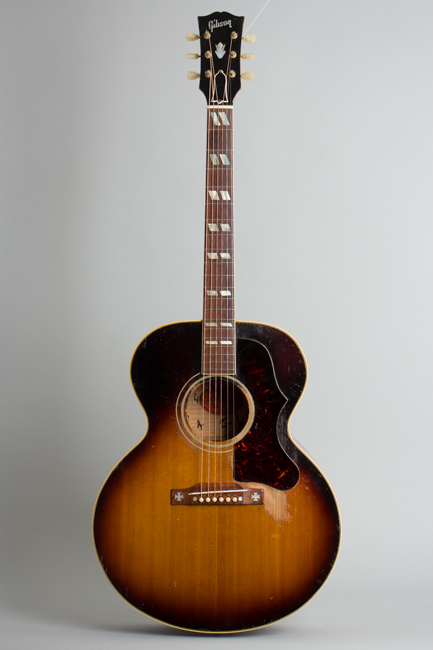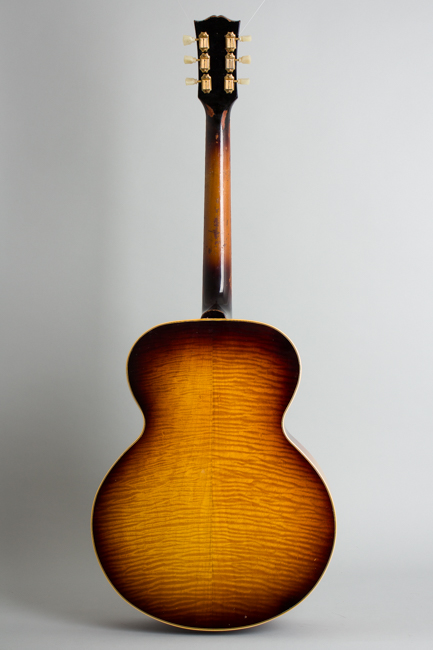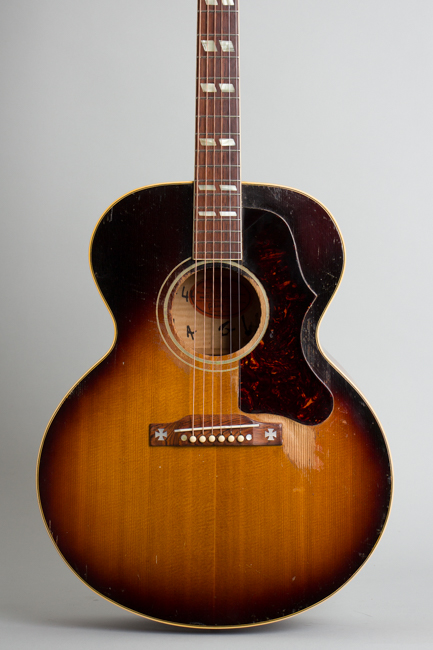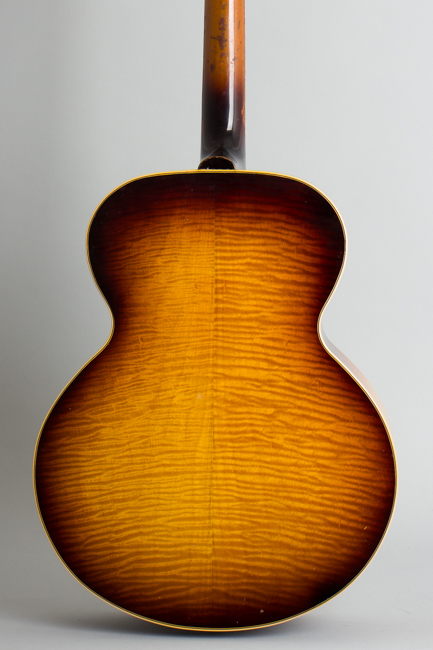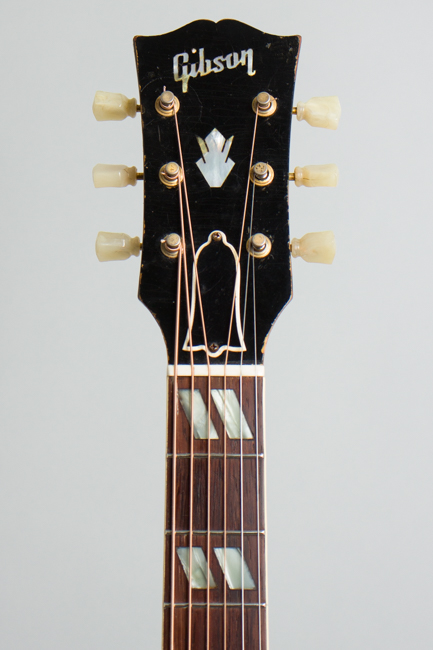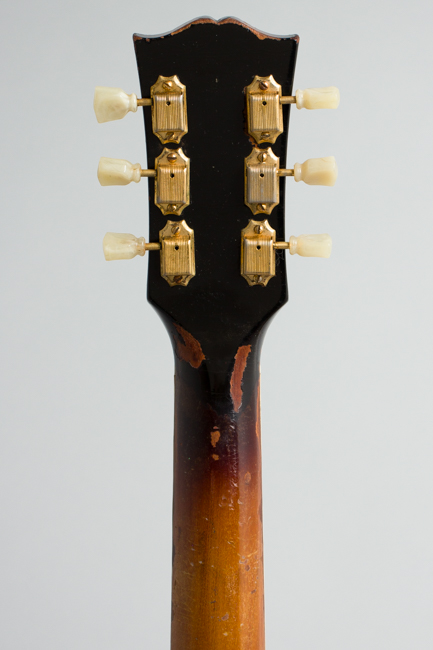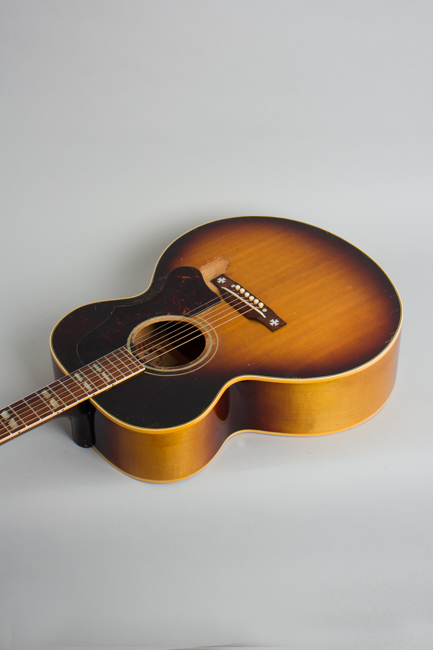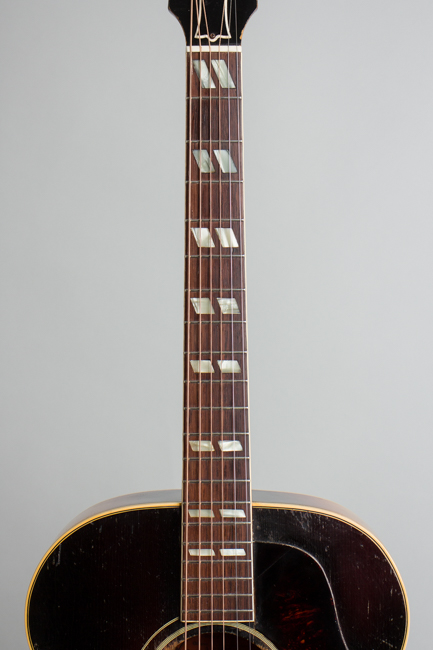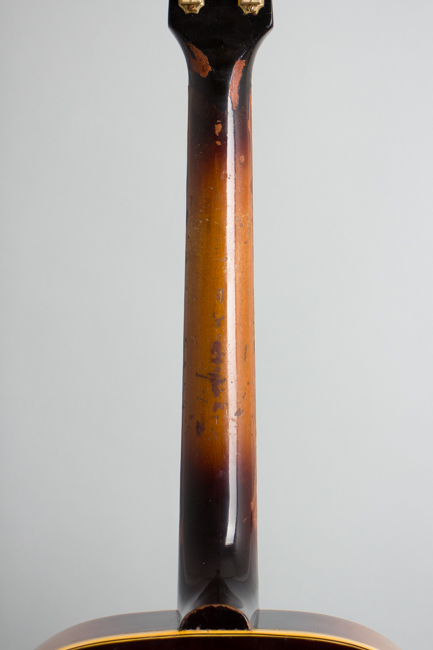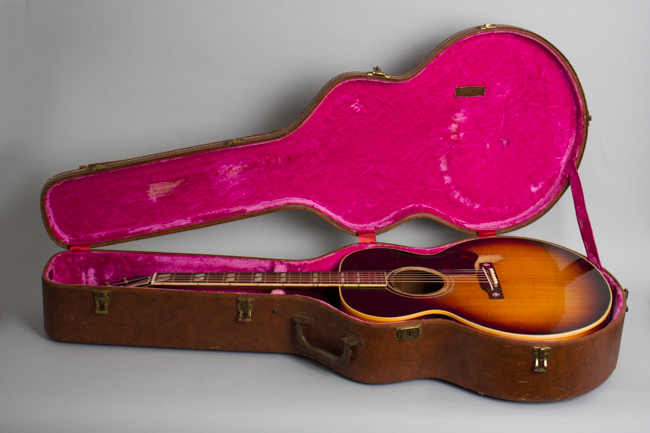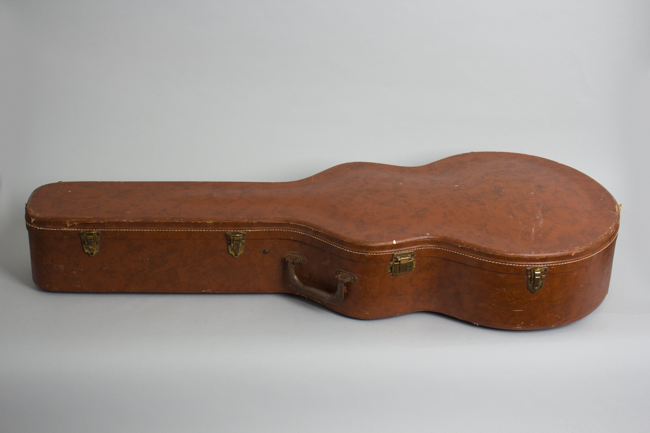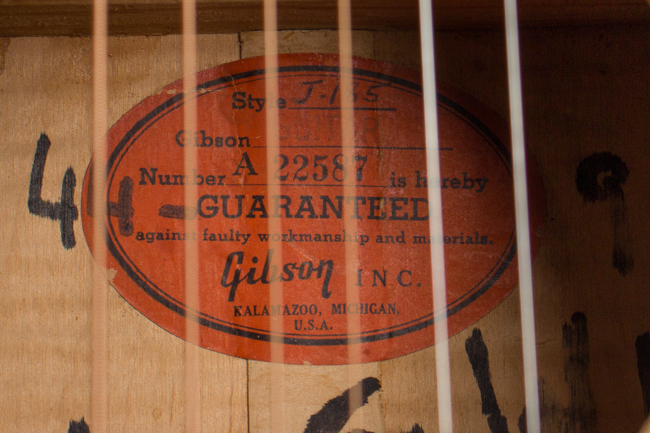Gibson J-185 Flat Top Acoustic Guitar (1956)
This item has been sold.
Item # 12135
Prices subject to change without notice.
Gibson J-185 Model Flat Top Acoustic Guitar (1956), made in Kalamazoo, Michigan, serial # A-22587, sunburst lacquer finish, flame maple back and sides, spruce top; mahogany neck with rosewood fingerboard, original brown hard shell case.
The top of this guitar shows evidence of a lot of heavy play time; one strum and it's easy to say why! The original Gibson J-185 has gained a formidable reputation over the decades as one of the absolute finest of Kalamazoo-made flat-tops, and remains a unique design. To some players this is simply one of the very best flat tops ever made. In production through the 1950s, this 16" narrow-waisted Jumbo model never established itself properly with players at the time but has garnered a splendid reputation in retrospect.
This guitar has a serial number indicating it was shipped in early April 1956, and a V-series Factory Order Number showing it was built not too long before. It was once owned by one Lila G. White, who wrote her name in large letters across the inside back, along with an ID number. Lila must have wanted to make sure nobody would be able to steal and pawn her fancy Gibson!
Lila's treasure is one of only 648 total sunburst J-185's built in the entire decade of the 1950s, 65 of which left Kalamazoo in 1956. These numbers are very small for such a well-regarded guitar, but this model suffered from the "Midline Blues". It seems most folks who could afford one went all out and bought a J-200, while the rest stuck with the familiar and much more affordable J-45 family. After two more years of slumping sales the J-185 was finally discontinued in 1959.
The J-185 represents Gibson's second attempt to create a less expensive guitar to complement the top-of-the-line "King of the Flat-tops" SJ-200, the first being the virtually dead-on-arrival SJ-100 of 1939-41. This is basically a plainer 16" wide version of the more "yee-haw" 17" J-200. The slightly smaller body retains the same narrow-waisted shape and materials but has lighter construction resulting in a handier, much more responsive guitar. The cosmetics are a bit plainer, but still make for an impressive-looking instrument.
This beauty has subtly flamed maple back and straight-grained spruce top under a shaded sunburst finish. The top and back are triple-bound and the tortoise celluloid pickguard is the same shape as the J-200 but thinner, and not ornamented with engraving. The medium/slim round-profile one-piece mahogany neck is topped with a bound rosewood fingerboard sporting Gibson's classic double parallelogram inlay. The unbound headstock has a crown inlay on the face and mounts gold-plated Kluson Deluxe tuners with keystone buttons.
A unique feature of the J-185 is pearl Maltese crosses inlaid on the wings of the "belly-up" rosewood bridge, an attractive if eccentric cosmetic touch reserved for this model alone. Since the 1950s the J-185's sound, feel and relative rarity have made it the most sought-after post-war Gibson flat-top. A few name players had one in the 1960s, notably blues legend Skip James at the end of his career. A different blues connection made them much desired among fingerstyle players: Reverend Gary Davis favored Gibson's J-200 during the 1960s, but the lighter and more responsive J-185 is a preferred instrument among many who follow in the Reverend's style.
This heavily played J-185 has had a lot of love strummed into it and is a superbly versatile guitar with an exceptionally smooth, rich, and expansive tone for a maple bodied instrument. This is not a "Clean one" but is of those guitars that truly lives up to its considerable reputation, simply one of Gibson's greatest if originally seriously underappreciated instruments.
Overall length is 41 in. (104.1 cm.), 16 1/16 in. (40.8 cm.) wide at lower bout, and 4 5/8 in. (11.7 cm.) in depth at side, taken at the end block. Scale length is 24 3/4 in. (629 mm.). Width of nut is 1 11/16 in. (43 mm.).
This is an all original and great-playing nearly 70 year old example of this much-desired instrument, one that has obviously seen some serious play. The wear is oddly concentrated; the top shows a LOT of strumming wear and there are marks to the back of the neck but the rest of the guitar is comparatively clean. The original lacquer finish on the back and sides shows some minor dings, dents and scrapes but is mostly pretty clean. The top is another story with several areas of deep pick wear through the lacquer into the wood, most heavily off the back edge of the pickguard (with a fairly deep "Pinky trench" between the back of the guard and front of the bridge) and just below the guard. The lower sound hole rim is worn well into the wood, with some loss above the soundhole and down between the strings as well. Lila (or somebody) was quite the hard strummer, but apparently did not wear a cowboy (or cowgirl) belt buckle.
The back of the neck shows some noticeable wear spots through the finish with dings, dents and scrapes along the spine and edges, with a couple of deep large scrapes just under the headstock, probably from some sort of strap attachment. The headstock has some checking and typical edge chipping.
Structurally the guitar is amazingly excellent with just one tiny repaired grain split to the top off the upper waist; there are no other cracks. The front corner of the pickguard has a pulled up spot that was reglued; there is a visible diagonal crack line there. The neck appears to have been very neatly reset to the original bridge which itself looks to have been lowered just a bit forward of the pins long ago. The bone saddle is newer, with a minor compensation set in. The small maple bridge plate is original and in good shape; the bridge retaining bolts have been removed.
The guitar has been neatly refretted with a close match to the original small fret wire showing no subsequent wear. It plays perfectly and sounds divine, both crisp and warm and very responsive foe a large bodied guitar. It rests happily in the original deep burgundy-lined brown Lifton HSC, less worn than one might expect. Lila took good card of her guitar, but played the heck out of it! Very Good + Condition.
The top of this guitar shows evidence of a lot of heavy play time; one strum and it's easy to say why! The original Gibson J-185 has gained a formidable reputation over the decades as one of the absolute finest of Kalamazoo-made flat-tops, and remains a unique design. To some players this is simply one of the very best flat tops ever made. In production through the 1950s, this 16" narrow-waisted Jumbo model never established itself properly with players at the time but has garnered a splendid reputation in retrospect.
This guitar has a serial number indicating it was shipped in early April 1956, and a V-series Factory Order Number showing it was built not too long before. It was once owned by one Lila G. White, who wrote her name in large letters across the inside back, along with an ID number. Lila must have wanted to make sure nobody would be able to steal and pawn her fancy Gibson!
Lila's treasure is one of only 648 total sunburst J-185's built in the entire decade of the 1950s, 65 of which left Kalamazoo in 1956. These numbers are very small for such a well-regarded guitar, but this model suffered from the "Midline Blues". It seems most folks who could afford one went all out and bought a J-200, while the rest stuck with the familiar and much more affordable J-45 family. After two more years of slumping sales the J-185 was finally discontinued in 1959.
The J-185 represents Gibson's second attempt to create a less expensive guitar to complement the top-of-the-line "King of the Flat-tops" SJ-200, the first being the virtually dead-on-arrival SJ-100 of 1939-41. This is basically a plainer 16" wide version of the more "yee-haw" 17" J-200. The slightly smaller body retains the same narrow-waisted shape and materials but has lighter construction resulting in a handier, much more responsive guitar. The cosmetics are a bit plainer, but still make for an impressive-looking instrument.
This beauty has subtly flamed maple back and straight-grained spruce top under a shaded sunburst finish. The top and back are triple-bound and the tortoise celluloid pickguard is the same shape as the J-200 but thinner, and not ornamented with engraving. The medium/slim round-profile one-piece mahogany neck is topped with a bound rosewood fingerboard sporting Gibson's classic double parallelogram inlay. The unbound headstock has a crown inlay on the face and mounts gold-plated Kluson Deluxe tuners with keystone buttons.
A unique feature of the J-185 is pearl Maltese crosses inlaid on the wings of the "belly-up" rosewood bridge, an attractive if eccentric cosmetic touch reserved for this model alone. Since the 1950s the J-185's sound, feel and relative rarity have made it the most sought-after post-war Gibson flat-top. A few name players had one in the 1960s, notably blues legend Skip James at the end of his career. A different blues connection made them much desired among fingerstyle players: Reverend Gary Davis favored Gibson's J-200 during the 1960s, but the lighter and more responsive J-185 is a preferred instrument among many who follow in the Reverend's style.
This heavily played J-185 has had a lot of love strummed into it and is a superbly versatile guitar with an exceptionally smooth, rich, and expansive tone for a maple bodied instrument. This is not a "Clean one" but is of those guitars that truly lives up to its considerable reputation, simply one of Gibson's greatest if originally seriously underappreciated instruments.
Overall length is 41 in. (104.1 cm.), 16 1/16 in. (40.8 cm.) wide at lower bout, and 4 5/8 in. (11.7 cm.) in depth at side, taken at the end block. Scale length is 24 3/4 in. (629 mm.). Width of nut is 1 11/16 in. (43 mm.).
This is an all original and great-playing nearly 70 year old example of this much-desired instrument, one that has obviously seen some serious play. The wear is oddly concentrated; the top shows a LOT of strumming wear and there are marks to the back of the neck but the rest of the guitar is comparatively clean. The original lacquer finish on the back and sides shows some minor dings, dents and scrapes but is mostly pretty clean. The top is another story with several areas of deep pick wear through the lacquer into the wood, most heavily off the back edge of the pickguard (with a fairly deep "Pinky trench" between the back of the guard and front of the bridge) and just below the guard. The lower sound hole rim is worn well into the wood, with some loss above the soundhole and down between the strings as well. Lila (or somebody) was quite the hard strummer, but apparently did not wear a cowboy (or cowgirl) belt buckle.
The back of the neck shows some noticeable wear spots through the finish with dings, dents and scrapes along the spine and edges, with a couple of deep large scrapes just under the headstock, probably from some sort of strap attachment. The headstock has some checking and typical edge chipping.
Structurally the guitar is amazingly excellent with just one tiny repaired grain split to the top off the upper waist; there are no other cracks. The front corner of the pickguard has a pulled up spot that was reglued; there is a visible diagonal crack line there. The neck appears to have been very neatly reset to the original bridge which itself looks to have been lowered just a bit forward of the pins long ago. The bone saddle is newer, with a minor compensation set in. The small maple bridge plate is original and in good shape; the bridge retaining bolts have been removed.
The guitar has been neatly refretted with a close match to the original small fret wire showing no subsequent wear. It plays perfectly and sounds divine, both crisp and warm and very responsive foe a large bodied guitar. It rests happily in the original deep burgundy-lined brown Lifton HSC, less worn than one might expect. Lila took good card of her guitar, but played the heck out of it! Very Good + Condition.
